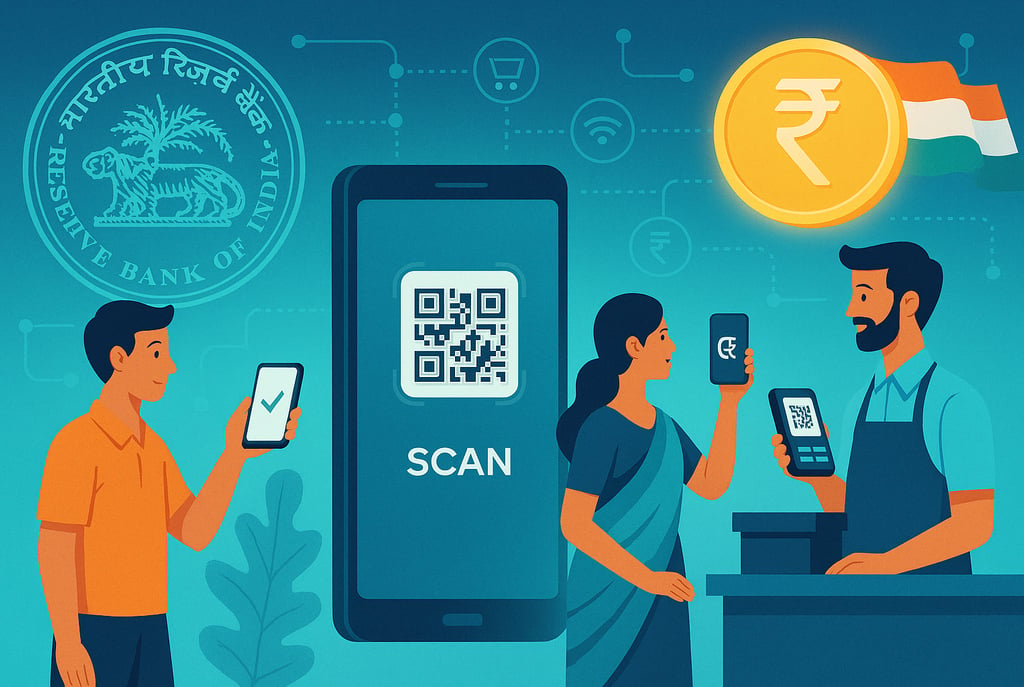Digital Rupee in India: What It Means for You and the Future of Money (2025 Guide)
4/15/20254 min read


Digital Rupee (CBDC) in India: What It Means for You and the Future of Money (2025 Guide)
India’s financial landscape is undergoing a revolutionary shift with the introduction of the Digital Rupee, the country’s official Central Bank Digital Currency (CBDC). Launched and regulated by the Reserve Bank of India (RBI), the Digital Rupee is gradually becoming a cornerstone of India’s digital economy. In 2025, its expansion signifies not just a technological advancement, but also a strategic step towards reshaping the way Indians perceive and interact with money.
This guide explores everything you need to know about the Digital Rupee—its meaning, benefits, usage, impact, and what it means for the future of finance in India.
Understanding the Digital Rupee
The Digital Rupee (also referred to as e₹) is a sovereign currency in digital form. It is issued and backed by the RBI, making it equivalent in value to the physical Rupee. However, unlike physical currency, it exists purely in electronic format and is stored digitally in wallets provided by authorized banks.
While many people confuse it with cryptocurrency, the Digital Rupee is entirely different. It is legal tender, centrally controlled, and does not exhibit volatility like private digital assets.
There are two main types of CBDCs in India:
Retail CBDC (e₹-R): Meant for everyday use by the general public.
Wholesale CBDC (e₹-W): Designed for interbank transactions among financial institutions.
Why the Digital Rupee Matters
The launch of the Digital Rupee represents a significant shift in how money is issued, transferred, and stored in India. Unlike traditional bank-based digital payments that rely on intermediaries, the Digital Rupee facilitates direct, final settlement between parties.
This reduces settlement risk and enhances efficiency. More importantly, it introduces programmable money, paving the way for new financial instruments, microtransactions, and government-to-citizen payments in a seamless, secure manner.
Key Benefits of the Digital Rupee
There are several reasons why the Digital Rupee stands out in India’s evolving financial system.
Firstly, it promotes financial inclusion. The Digital Rupee can be used through basic mobile applications without requiring access to a bank account. This helps extend digital payments to remote and underserved regions.
Secondly, it reduces the cost of handling physical cash. From printing and distribution to storage and replacement, the lifecycle of paper currency is expensive. The Digital Rupee streamlines this process by offering a virtual alternative.
Thirdly, it ensures secure and instant settlement. Since the Digital Rupee is issued by the RBI, the transaction is final and does not require reconciliation through third-party networks.
Finally, it offers the ability to perform offline payments. In select pilot regions, users can complete transactions without internet connectivity, increasing resilience in areas with limited access.
Digital Rupee vs UPI and Wallets
Many Indians already rely heavily on UPI, mobile wallets, and internet banking. While these platforms are efficient, they are not legal tender. They operate by instructing banks to move money on behalf of users.
The Digital Rupee, in contrast, is money itself in digital form. When someone receives e₹, it is not a claim on a bank—it is the currency itself. This offers a completely different model for digital transactions and can reduce dependence on traditional banking intermediaries.
Where the Digital Rupee Is Being Used in 2025
Since its pilot launch in late 2022, the Digital Rupee has expanded across numerous cities. It is currently available to users through participating banks including the State Bank of India, ICICI Bank, HDFC Bank, Axis Bank, and others.
In 2025, it is being accepted in retail outlets, government offices, public transport systems, and digital commerce platforms. Furthermore, select government subsidies and welfare payments may soon be delivered directly in Digital Rupee format, ensuring faster and more transparent disbursement.
How to Access and Use the Digital Rupee
Users can access the Digital Rupee by downloading a dedicated CBDC wallet provided by their bank. Once installed, this wallet allows them to:
Load Digital Rupees from their bank account
Make person-to-person and person-to-merchant payments via QR codes
View transaction history
Transfer money back to their bank account if needed
Each transaction is completed in real-time, without delays or intermediary approval.
Implications for Individuals, Businesses, and the Economy
For individuals, the Digital Rupee offers a cash-like experience in a digital format. It enhances privacy, eliminates the need for physical currency, and simplifies transactions across sectors.
Businesses stand to gain significantly. The Digital Rupee reduces settlement time, improves liquidity, and reduces payment gateway fees. It also integrates easily with POS systems and can be used even in offline environments.
From an economic perspective, the Digital Rupee provides the RBI with better oversight of the currency in circulation. It strengthens monetary policy transmission, enhances tax compliance, and helps reduce black money circulation by bringing more transactions into the digital net.
Challenges and Considerations
Despite its promise, the Digital Rupee faces several challenges.
Digital literacy remains a barrier in rural areas. Many users are still unfamiliar with CBDC wallets and require assistance in understanding their utility.
Concerns around privacy and surveillance are also valid. As a government-issued currency, the Digital Rupee allows for greater traceability. While this supports transparency, it may raise questions around user data and freedom.
Moreover, the infrastructure required to support large-scale offline transactions is still under development. Nevertheless, the RBI is addressing these concerns through phased rollouts and continuous feedback loops.
What the Future Holds
India is at the forefront of digital currency innovation. With a solid foundation laid by UPI, Aadhaar, and Jan Dhan, the Digital Rupee is poised to accelerate digital adoption even further.
In the near future, the Digital Rupee may be integrated with AI, smart contracts, and cross-border CBDC networks. This would allow Indian users to send money globally with lower fees and faster settlement.
Eventually, the Digital Rupee could power programmable financial services, micro-lending, automated subsidies, and much more—ushering in a new era of transparent, inclusive finance.
Conclusion
The Digital Rupee in India marks a paradigm shift in the country’s monetary framework. It is not just a technological advancement, but a foundational change in how currency operates in the digital age.
As the RBI continues to expand its scope in 2025, individuals, businesses, and financial institutions must prepare to embrace this innovation. Understanding its purpose, benefits, and future impact is essential to staying ahead in a digitally transformed economy.
About One Solution
Quick Links
Contact Info
One Solution — Your trusted partner for financial success.
📍 F17, Grand Plaza, Paltan Bazar
Guwahati, Kamrup (M), Assam
India, Pin: 781008
📞 9650072280
© 2025 One Solution. All Rights Reserved.
